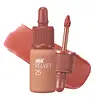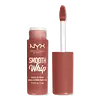What's inside
What's inside
 Key Ingredients
Key Ingredients

No key ingredients
 Benefits
Benefits

 Concerns
Concerns

 Ingredients Side-by-side
Ingredients Side-by-side

Dimethicone
EmollientDimethicone/Vinyl Dimethicone Crosspolymer
Skin ConditioningPolyglyceryl-2 Triisostearate
EmulsifyingWater
Skin ConditioningCetyl PEG/PPG-10/1 Dimethicone
EmulsifyingCI 77492
Cosmetic ColorantIsododecane
EmollientButylene Glycol
HumectantCI 77891
Cosmetic ColorantVinyl Dimethicone/Methicone Silsesquioxane Crosspolymer
Dimethicone Crosspolymer
Emulsion StabilisingCI 77491
Cosmetic ColorantVp/Hexadecene Copolymer
PEG-60 Hydrogenated Castor Oil
Emulsifying1,2-Hexanediol
Skin ConditioningDiisostearyl Malate
EmollientCI 77499
Cosmetic ColorantDisteardimonium Hectorite
StabilisingCI 15850
Cosmetic ColorantCI 45410
Cosmetic ColorantPhenoxyethanol
PreservativeParfum
MaskingPropylene Carbonate
SolventAluminum Hydroxide
EmollientCI 17200
Cosmetic ColorantCI 19140
Cosmetic ColorantCI 42090
Cosmetic ColorantDimethicone, Dimethicone/Vinyl Dimethicone Crosspolymer, Polyglyceryl-2 Triisostearate, Water, Cetyl PEG/PPG-10/1 Dimethicone, CI 77492, Isododecane, Butylene Glycol, CI 77891, Vinyl Dimethicone/Methicone Silsesquioxane Crosspolymer, Dimethicone Crosspolymer, CI 77491, Vp/Hexadecene Copolymer, PEG-60 Hydrogenated Castor Oil, 1,2-Hexanediol, Diisostearyl Malate, CI 77499, Disteardimonium Hectorite, CI 15850, CI 45410, Phenoxyethanol, Parfum, Propylene Carbonate, Aluminum Hydroxide, CI 17200, CI 19140, CI 42090
Dimethicone
EmollientTalc
AbrasiveDimethicone Crosspolymer
Emulsion StabilisingCI 77891
Cosmetic ColorantPolyglyceryl-2 Triisostearate
EmulsifyingIsododecane
EmollientCI 77492
Cosmetic ColorantCI 77491
Cosmetic ColorantIsobutylmethacrylate/Bis-Hydroxypropyl Dimethicone Acrylate Copolymer
1,2-Hexanediol
Skin ConditioningTheobroma Cacao Seed Butter
EmollientButyrospermum Parkii Butter
Skin ConditioningTribehenin
EmollientSorbitan Isostearate
EmulsifyingCI 77120
Cosmetic ColorantAluminum Hydroxide
EmollientEthylhexylglycerin
Skin ConditioningSorbic Acid
PreservativePhenoxyethanol
PreservativeCI 15850
Cosmetic ColorantCI 77499
Cosmetic ColorantParfum
MaskingDimethicone, Talc, Dimethicone Crosspolymer, CI 77891, Polyglyceryl-2 Triisostearate, Isododecane, CI 77492, CI 77491, Isobutylmethacrylate/Bis-Hydroxypropyl Dimethicone Acrylate Copolymer, 1,2-Hexanediol, Theobroma Cacao Seed Butter, Butyrospermum Parkii Butter, Tribehenin, Sorbitan Isostearate, CI 77120, Aluminum Hydroxide, Ethylhexylglycerin, Sorbic Acid, Phenoxyethanol, CI 15850, CI 77499, Parfum
 Reviews
Reviews

Ingredients Explained
These ingredients are found in both products.
Ingredients higher up in an ingredient list are typically present in a larger amount.
1,2-Hexanediol is a synthetic liquid and another multi-functional powerhouse.
It is a:
- Humectant, drawing moisture into the skin
- Emollient, helping to soften skin
- Solvent, dispersing and stabilizing formulas
- Preservative booster, enhancing the antimicrobial activity of other preservatives
Aluminum Hydroxide is a form of aluminum. It can be naturally found in nature as the mineral gibbsite. In cosmetics, Aluminum Hydroxide is used as a colorant, pH adjuster, and absorbent.
As a colorant, Aluminum Hydroxide may add opacity, or reduce the transparency. Aluminum hydroxide is contains both basic and acidic properties.
According to manufacturers, this ingredient is an emollient and humectant. This means it helps hydrate the skin.
In medicine, this ingredient is used to help relieve heartburn and help heal ulcers.
There is currently no credible scientific evidence linking aluminum hydroxide in cosmetics to increased cancer risk.
Major health organizations allow the use of aluminum hydroxide in personal care products and have not flagged it as a carcinogenic risk at typical usage levels.
Learn more about Aluminum HydroxideCi 15850 is the pigment color red. It is an azo dye and created synthetically.
Azo dyes need to be thoroughly purified before use. This allows them to be more stable and longer-lasting.
This ingredient is common in foundations, lipsticks, and blushes. This color is described as brown/orangey red.
It has many secondary names such as Red 6 and Red 7. According to a manufacturer, Red 6 usually contains aluminum.
Learn more about CI 15850Ci 77491 is also hydrated iron III oxide. It's sole purpose is to give a red/pink hue to products.
Iron III oxides are classified as inorganic chemicals for coloring.
Synthetically created Ci 77491 is considered safer than those naturally found. This is because the synthetically created version may contain less impurities. Iron oxides are generally non-toxic and non-allergenic.
Learn more about CI 77491Ci 77492 is also hydrated iron III oxide. It's sole purpose is to give a yellow hue to products.
Iron III oxides are classified as inorganic chemicals for coloring.
Synthetically created Ci 77492 is considered safer than those naturally found. This is because the synthetically created version may contain less impurities. Iron oxides are generally non-toxic and non-allergenic.
Learn more about CI 77492Ci 77499 is also hydrated iron III oxide. It is created from mixing red and black iron oxides. This helps give shades of darkness to a product.
Iron III oxides are classified as inorganic chemicals for coloring.
Ci 77891 is a white pigment from Titanium dioxide. It is naturally found in minerals such as rutile and ilmenite.
It's main function is to add a white color to cosmetics. It can also be mixed with other colors to create different shades.
Ci 77891 is commonly found in sunscreens due to its ability to block UV rays.
Learn more about CI 77891Dimethicone is a type of synthetic silicone created from natural materials such as quartz.
What it does:
Dimethicone comes in different viscosities:
Depending on the viscosity, dimethicone has different properties.
Ingredients lists don't always show which type is used, so we recommend reaching out to the brand if you have questions about the viscosity.
This ingredient is unlikely to cause irritation because it does not get absorbed into skin. However, people with silicone allergies should be careful about using this ingredient.
Note: Dimethicone may contribute to pilling. This is because it is not oil or water soluble, so pilling may occur when layered with products. When mixed with heavy oils in a formula, the outcome is also quite greasy.
Learn more about DimethiconeDimethicone Crosspolymer is a silicone created by modifying dimethicone with hydrocarbon side chains. Due to its large size, it does not penetrate skin. It is considered non-occlusive.
Dimethicone Crosspolymer is used to stabilize and thicken products. It also helps give products a silky feel.
Isododecane is a fragrance, emollient, and solvent.
As an emollient, it helps your skin stay soft and hydrated. Emollients help trap moisture into your skin.
Isododecane's role as a solvent makes it a great texture enhancer. It spreads smoothly on skin and does not leave a sticky feeling behind. Isododecane also helps prevent color transfer in makeup products.
Isododecane is not absorbed into skin.
Learn more about IsododecaneParfum is a catch-all term for an ingredient or more that is used to give a scent to products.
Also called "fragrance", this ingredient can be a blend of hundreds of chemicals or plant oils. This means every product with "fragrance" or "parfum" in the ingredients list is a different mixture.
For instance, Habanolide is a proprietary trade name for a specific aroma chemical. When used as a fragrance ingredient in cosmetics, most aroma chemicals fall under the broad labeling category of “FRAGRANCE” or “PARFUM” according to EU and US regulations.
The term 'parfum' or 'fragrance' is not regulated in many countries. In many cases, it is up to the brand to define this term.
For instance, many brands choose to label themselves as "fragrance-free" because they are not using synthetic fragrances. However, their products may still contain ingredients such as essential oils that are considered a fragrance by INCI standards.
One example is Calendula flower extract. Calendula is an essential oil that still imparts a scent or 'fragrance'.
Depending on the blend, the ingredients in the mixture can cause allergies and sensitivities on the skin. Some ingredients that are known EU allergens include linalool and citronellol.
Parfum can also be used to mask or cover an unpleasant scent.
The bottom line is: not all fragrances/parfum/ingredients are created equally. If you are worried about fragrances, we recommend taking a closer look at an ingredient. And of course, we always recommend speaking with a professional.
Learn more about ParfumPhenoxyethanol is a preservative that has germicide, antimicrobial, and aromatic properties. Studies show that phenoxyethanol can prevent microbial growth. By itself, it has a scent that is similar to that of a rose.
It's often used in formulations along with Caprylyl Glycol to preserve the shelf life of products.
This ingredient is a form of glycerin with emulsifying and emollient properties.
As an emulsifier, this ingredient helps keep products together while adding a thick texture. The manufacturer states this ingredient has emollient properties. Emollients help keep the skin hydrated by trapping moisture in.
Polyglyceryl-2 Triisostearate is created by reacting diglycerin and isostearic acid. Due to the isostearic acid base, it may not be safe for Malassezia or fungal acne.
Learn more about Polyglyceryl-2 Triisostearate